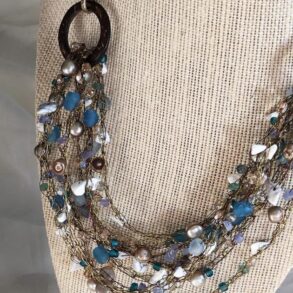Art Market
Hollie McLaughlin-Martin
Apr 23, 2024 3:48PM
MAHKU (Movimento dos Artistas Huni Kuin), external view of Kapewe Pukeni [Bridgealligator], 2024, at “Foreigners Everywhere,” at the 60th International Art Exhibition – La Biennale di Venezia. Photo by AVZ. Courtesy of La Biennale di Venezia.
The global art world descended on Venice last week for the opening of the 2024 Biennale de Arte, also known as the Venice Biennale. The weather might have been patchy throughout, but the activity across the city was consistently abuzz during almost every waking (and unwaking) hour. The sheer number of parties, events, openings, and shows meant that FOMO was an unavoidable feeling amongst those with even the most packed agendas.
From the expansive main exhibition “Foreigners Everywhere” to the sprawling national pavilions and satellite shows dotted around the city, the “Olympics of the art world” is overflowing with artistic activity and discoveries.
As the Biennale’s preview week concluded at the end of last week, seven collectors shared their highlights with Artsy, along with what makes the Venice Biennale such a special event.
Patrizia Sandretto Re Rebaudengo
Founder and president of Fondazione Sandretto Re Rebaudengo
Portrait of Patrizia Sandretto Re Rebaudengo. Courtesy of Patrizia Sandretto Re Rebaudengo.
Advertisement
When arriving in Venice, you immediately perceive its innate connection to art from every era. I have always considered it a place beyond common imagination, capable of paying special attention to the magic of creation. There is a sentence from the introduction to the catalogue Sogni/Dreams—which collects the dreams of 100 artists and was published by Fondazione Sandretto Re Rebaudengo on the occasion of the 48th Venice Biennial in 1999—that I always find perfect to describe its atmosphere: “Venice…contains, more than any other city, the reality of dreams. It is a city that wants to survive transforming the past into a proposition for the future, nostalgia into necessity, time into activity.”
Since the 1990s, I have not missed one [Venice Biennale], be it Art, Cinema, or Architecture, and through Fondazione Sandretto Re Rebaudengo, I have supported the Biennale, Italian pavilion, and other projects. This year, the Fondazione proudly supported Sol Calero’s “Pabellón Criollo” in the Giardini. This structure reflects upon relevant themes for our times, such as cultural cross-pollination and the topic of reuse.
Eun-Me Ahn, installation view of “Pinky Pinky ‘Good’: San Giacomo’s Leap into Tomorrow,” at Fondazione Sandretto Re Rebaudengo, Isola di San Giacomo, 2024. Courtesy of Fondazione Sandretto Re Rebaudengo.
Additionally, we were delighted to present “Pinky Pinky ‘Good’: San Giacomo’s Leap into Tomorrow,” a performance exhibition by Eun-Me Ahn on Isola di San Giacomo in the Venetian lagoon. Curated by Hans Ulrich Obrist, the project by the Korean artist, dancer, and choreographer [was] conceived for Isola di San Giacomo in the Venice Lagoon, the third venue of Fondazione Sandretto Re Rebaudengo that is set to open to the public in 2026. “Pinky Pinky ‘Good’” is a collective and transformative ritual for blessing, inspired by Korean shamanic tradition. Eun-Me Ahn invoked the spirits of the past of the island, honoring its new existence as a place for contemporary art.
Elsewhere, I also found Pierre Huyghe’s exhibition at Palazzo Grassi and Berlinde De Bruyckere’s show at the Abbazia di San Giorgio Maggiore to be captivating. I’ve been following De Bruyckere’s work for quite some time now, and she previously had a solo exhibition, “Aletheia” in 2019, at the Fondazione in Turin. I’m fortunate to have several of her works in my collection.
I also thought that Wael Shawky’s Egyptian pavilion was brilliant and enjoyed Guglielmo Castelli’s exhibition at Palazzetto Tito, an artist I have been following closely. The Biennale is the perfect venue to discover new, incredible artworks and to start imagining new collaborations.
Beatrice Bulgari
President of Fondazione In Between Art Film
Portrait of Beatrice Bulgari. Photo by Gianmarco Chieregato Courtesy of Beatrice Bulgari.
I haven’t missed an edition of the Venice Biennale for I don’t know how many years. For me, it is an essential event in the international art calendar. For the past four editions with Fondazione In Between Art Film, I have supported the central exhibition and co-produced works, as in the case of the video work by Karimah Ashadu, Machine Boys, which is installed this year at the Corderie as part of the beautiful exhibition “Foreigners Everywhere.” For collectors and patrons, the Venice Biennale is a unique opportunity to not only get a truly global vision of the current state of art, but to also support works that everybody will see.
This edition of the Biennale features many artists who use moving images in masterful ways. I was fascinated by the work that Wael Shawky conceived for the Egyptian pavilion; he has a unique voice on the international scene, and it was a lucky coincidence to be able to see his solo exhibition at Palazzo Grimani in Venice at the same time. I didn’t want to leave John Akomfrah’s British pavilion—he has influenced so many generations of artists that today are producing vital works. I was also touched by Yael Bartana’s filmic contribution to the German pavilion.
John Akomfrah, “Listening All Night To The Rain,” at the British Pavillion at the 60th International Art Exhibition – La Biennale di Venezia, 2024. Courtesy of the British Council.
I would like to praise Adriano Pedrosa’s effort in decentralizing our gaze in such an elegant and passionate way: His Biennale is an exhibition to see and revisit and from which I am sure we will all learn a lot.
Valeria Schäfer and Marco
Gallerist and collectors
Portrait of Valeria Schäfer and Marco. Courtesy of Valeria Schäfer Curina and Marco.
We’ve been attending the Venice Biennale since 2013 (we actually met each other here) and return because of the quantity and variety of things we can see. One amazing pavilion for us was the German pavilion, which included works by Yael Bartana: We really liked her approach and techniques, especially her video and sound installations. Another highlight was seeing the works of Mexican artist Barbara Sanchez-Kane that really grabs your attention. We are familiar with her beautiful drawings and paintings, and the Biennale also included her sculpture work.
We highly recommend seeing the Swiss pavilion, specifically works by Guerreiro Do Divino Amor. The pavilion focuses on national heritage, and his works contain a lot of baroque expressions, making viewers question the topics of heritage and national identities.
Finally, we discovered the works of Agnes Questionmark, a transgender artist. Seeing this artist’s works made us realize that transgender artists are underrepresented in our collection. After seeing this Biennale, we really want to focus more on transgender artists and have more representation within our collection.
Dr. Basel Dalloul
Founder and chairman of the Ramzi and Saeda Dalloul Art Foundation
Portrait of Dr. Basel Dalloul. Courtesy of Dr. Basel Dalloul.
This [is] my fourth consecutive time, coming to the Biennale as both a collector and jury member of the Lebanese pavilion. This year, my foundation also has the honor of having 10 pieces in Adriano Pedrosa’s show “Foreigners Everywhere.”
As far as the appeal [of the Venice Biennale] to collectors is concerned…serious collectors couldn’t find a more concentrated grouping of global art in one place and of the quality that makes it to the Biennale.
Judith Lauand, installation view of Acervo 290, concreto 18, 1954, in “Foreigners Everywhere” at the 60th International Art Exhibition – La Biennale di Venezia, 2024. Photo by Matteo de Mayda. Courtesy of La Biennale di Venezia.
As a collector, I was very impressed with Pedrosa’s choice of artists from the Global South, including but not limited to, Samia Halaby, Wael Shawky, Manal AlDowayan, Mounira Al Solh, Issac Chong Wai, Susanne Wagner, Shalom Kufakwatenzi, Claudia Alarcòn, Liverpool Badi, Nour Jouda, Aydeé Rodríguez López, Judith Lauand, Mohamed Chebaa, Mohamed Melehi, Tahia Halim, Fred Graham, Frieda Toranza Jaeger, and Yinka Shonibare, as well as several of whom I didn’t know and was impressed by.
The most impressive off-site venues were those of AlUla, where Ahmed Mater’s model for his upcoming “mirage” installation was mind-blowing; and Qatar’s cinema installation was also impressive. As far as museum shows were concerned, Willem de Kooning’s show at the Gallerie dell’Accademia was my favorite.
Oliva Sartogo
Co-founder of VIV Arts
Portrait of VIV Arts co-founders Oliva Sartogo (left) and Carlota Dochao Naveira (right). Courtesy of VIV Arts.
I have been attending the Biennale since I was a child, as we used to come as a family with my parents. When I was 21, I was blown away by the French pavilion, Anri Sala’s Ravel Ravel and Unravel (2013). I was into electro music at the time and the work was such a revelation, a combination of movement and melody.
The Biennale is a unique moment, as you discover artists from all around the world through the eyes of curators. The context and the pavilions’ architecture are also such a great limitation. Artists usually express themselves in a strong way and it’s always very essential to their practice. I usually fall in love with an artist’s practice during the Biennale and then look at their works in their galleries and museums.
Christian Nyampeta, installation view of When Rain Clouds Gather, 2024, in “Nebula,” in tFondazione In Between Art Film at Complesso dell’Ospedaletto, Venice, 2024. Photo courtesy of Oliva Sartogo.
[At the] Egyptian Pavilion by Wael Shawky, I loved his world, an immersive narrative that references history and literature. Drama 1882, created for the Biennale, is a filmed rendition of an original musical play, exploring Egypt’s nationalist Urabi revolution in the 19th century against imperial and colonial influence.
Also, Julie Mehretu’s work on the second floor of Palazzo Grassi is breathtaking: strong, dynamic, and powerful. Christian Nyampeta’s video, an exhibition with eight new video installations commissioned and produced by Fondazione In Between Art Film on the occasion of the Biennale Arte 2024, is another highlight. The video features Nyampeta talking about the Rwandan genocide in an outstandingly poetic way.
Edoardo Monti
Collector and founder of Palazzo Monti
Portrait of Edoardo Monti. Courtesy of Edoardo Monti.
This is my sixth consecutive year coming to the opening of the Biennale. There’s still nothing quite like Venice. You have so many curators and artists and gallerists in a very small city, and you bump into each other without making any plans to.…It’s getting better year by year and you can really immerse yourself in a 360-degree cultural experience.
I myself do tons of research online on Artsy, Instagram, and other websites, [but] there’s nothing like visiting someone in person and seeing the work in real life. I travel to other fairs, but there’s still nothing quite like Venice. It’s an investment of time that gets paid back within minutes of being on the island.
Installation view of “The Altersea Opera” at the Nordic Countries Pavilion at the 60th International Art Exhibition – La Biennale di Venezia, 2024. Photo by Matteo de Mayda. Courtesy of La Biennale di Venezia.
I really enjoyed the Nordic pavilion [which joins together Sweden, Finland, and Norway]. The architecture of the space—concrete and light building with trees growing inside—is just wonderful, and the concept of the pavilion is beautiful. It’s almost like a cultural embassy built and run by each country. You can see a reflection of how much they care about the arts back home.
At the International Art Exhibition, three artists who stood out were Bertina Lopes, Maria Taniguchi, and Nena Saguil. Another highlight was going to Palazzo Pisani Moretta. After visiting the Nigerian pavilion, we went across the Grand Canal to Palazzo Pisani Moretta [for dinner], which was simply amazing. A very peculiar element of the palazzo is that it’s the only one still officially allowed to be completely candle-lit—there’s no electricity in the palace. Any light that you may find that’s artificial is battery-powered. The entire dinner was simply amazing.
Alain Servais
Investment banker and collector
Portrait of Alain Servais. Courtesy of Alain Servais.
This year’s Biennale is a very good edition. It’s my 13th time in attendance, and this year is one of the best. For me, the Venice Biennale is obligatory to attend to get a feel for what the situation currently is in the art world.
In my opinion, the art world is a machine where networking is very important. As a collector, coming to the opening week allows me to have a great understanding of the artworks. For example, I had a chance to tour the Saudi Arabian pavilion with the curator. It [provides an] understanding of the work which you could not replicate in any way. I also spoke to curators from China, Indonesia, Mexico, Germany, and so on. It’s an opportunity to meet all those people that you cannot always meet regularly around the world.
It’s clear that the pavilions at the Biennale have specific themes this year. The first theme I noticed was extractivism, which is the removal of natural resources, which has a direct link to colonialism. The scars of extractivism don’t go away, and the consequence of extractivism is, of course, the destruction of the environment. There is an environmental question about what will happen to the future in general.
Koo Jeong A, installation view of “Odorama Cities” at the Korean Pavilion at the 60th International Art Exhibition – La Biennale di Venezia, 2024. Photo by MZO. Courtesy of La Biennale di Venezia.
Many of the pavilions also highlight the theme of capitalism. In the current state of the world, we don’t really know how long we can continue with the inequalities between the wealthy and the less wealthy.
There is also a strong emphasis on sound and scent. I’ve never seen this much focus on sound. A lot of pavilions are very sound- and scent-based. The Korean pavilion is 100% scent, but it’s not only there. Many pavilions seem to have placed a focus on physical sensations rather than just the visual.
So many artists stood out to me this year, many of whom whose work touches on the themes I mentioned. In the Spanish pavilion, Sandra Gamarra’s work is very striking. Her works examine Spain’s colonial past and the ongoing repercussions of that. In “Foreigners Everywhere,” I was drawn to Gabrielle Goliath’s work. Her installations and performances look at the frameworks of oppression and inequality. And then, there was Daniel Otero’s very striking video installations that look at multidirectional migrations. There is such a long list of incredible artists at this year’s Biennale.
Hollie McLaughlin-Martin




